The Gerenuk, also known as Litocranius walleri, is a captivating species of antelope found in the arid and semi-arid regions of East Africa. With its distinctive appearance and unique feeding behavior, the Gerenuk has captured the attention of wildlife enthusiasts and researchers alike.
In this article, we will delve into the intriguing world of the Gerenuk, exploring its physical characteristics, habitat, feeding habits, behavior, and more.
Overview
| Characteristic | Gerenuks |
|---|---|
| Scientific Name | Litocranius walleri |
| Family | Bovidae |
| Type | Mammal |
| Order | Artiodactyla |
| Temperament | Skittish yet alert |
| Lifespan | Up to 12 years |
| Size | Height at shoulder: 80 to 105 cm (31 to 41 in) |
| Weight | 28 to 52 kg (62 to 115 lb) |
| Diet | Herbivorous, primarily browsing on leaves, shoots, and twigs |
| Distribution | Eastern Africa, including Kenya, Somalia, and Ethiopia |
| Habitat | Arid and semi-arid areas, including dry savannahs and bushlands |
| Other names | Waller’s Gazelle |
Physical Characteristics of Gerenuk
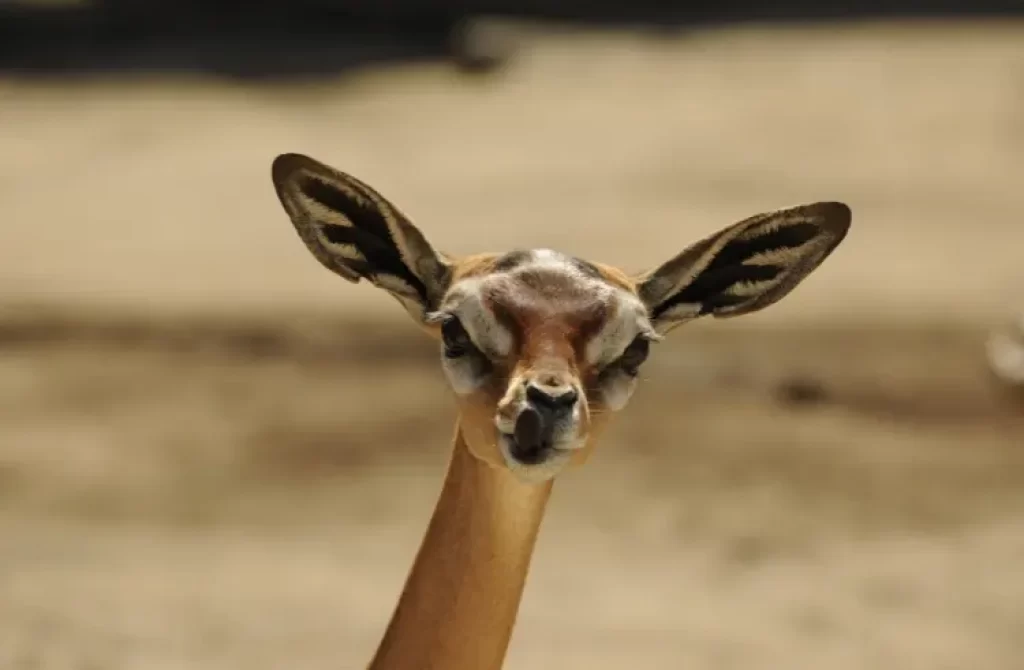
The Gerenuk, scientifically known as Litocranius walleri, is a captivating and visually distinct species of antelope found in the arid regions of East Africa.
Its unique physical characteristics and remarkable adaptations make it a fascinating creature to study and observe. Let’s delve into the details of what the Gerenuk looks like:
Slender Body and Long Legs
The Gerenuk has a slender body with a streamlined shape that allows it to navigate through dense vegetation with ease. Its long and thin legs are adapted for agility and swift movement, enabling it to traverse its arid habitat with remarkable grace.
Elongated Neck
One of the most striking features of the Gerenuk is its elongated neck. This elongation is an adaptation that enables the Gerenuk to reach high branches and leaves that are typically out of reach for other antelopes.
With its exceptional neck length, the Gerenuk can browse on vegetation that is beyond the reach of other herbivores, granting it a unique feeding advantage.
Coloration and Camouflage
The Gerenuk sports a reddish-brown coat that blends harmoniously with its arid surroundings. This coloration provides effective camouflage, helping the Gerenuk to remain inconspicuous and evade potential predators.
Additionally, the lighter-colored underbelly of the Gerenuk acts as a form of disruptive coloration, breaking up its outline and making it more challenging for predators to detect.
Expressive Eyes and Prominent Ears
The Gerenuk possesses large, expressive eyes that are adapted for excellent vision. Its keen eyesight allows it to spot distant threats or potential food sources in its environment.
Complementing its vision are the Gerenuk’s prominent ears, which are not only aesthetically appealing but also serve as powerful sensory organs. The large ears enable the Gerenuk to detect sounds, alerting it to the presence of predators or the calls of other individuals.
Impressive Male Horns
Adult male Gerenuks exhibit a remarkable feature that distinguishes them from their female counterparts: impressive horns. These horns are corkscrew-shaped, curving upward and backward from the top of the head.
The horns can grow to lengths of up to 24 inches (60 cm), and their unique shape adds to the Gerenuk’s distinctive appearance. Male Gerenuks use their horns for territorial displays and combat during mating season.
Habitat and Distribution
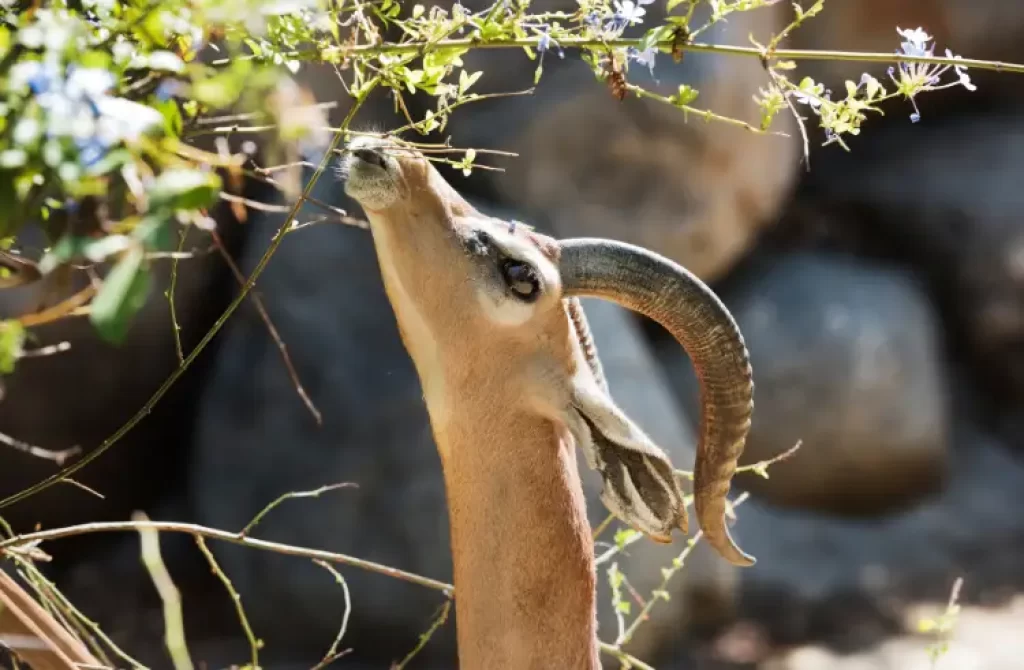
The Gerenuk, or Litocranius walleri, is a fascinating antelope species that has adapted to survive in some of the harshest and most arid environments of East Africa. Its unique physical and behavioral characteristics make it well-suited for its specialized habitat.
Dry Woodlands and Thorny Scrublands
One of the key habitats for the Gerenuk is dry woodlands and thorny scrublands. These areas are characterized by sparse vegetation, thorny shrubs, and scattered trees.
The Gerenuk’s long, slender neck and legs are perfectly designed for browsing on the leaves and tender shoots of these plants, allowing it to reach higher foliage that other herbivores cannot access.
By utilizing its elongated neck and standing on its hind legs, the Gerenuk can extend its reach and feed on leaves and branches that are out of reach for most other animals.
Savannas
The Gerenuk also inhabits savannas, which are open grasslands with scattered trees. Although grass is not the primary component of its diet, the Gerenuk can still find suitable food sources in these areas.
It can selectively browse on the leaves, flowers, and fruits of shrubs and trees present in the savanna, supplementing its diet with these resources. The open nature of the savannas provides the Gerenuk with ample space to move around and forage for food.
Deserts
In addition to woodlands and savannas, the Gerenuk is also known to inhabit certain desert regions. These deserts have extremely limited vegetation, and the Gerenuk has developed unique adaptations to survive in these harsh environments.
It can withstand long periods without water by obtaining moisture from the plants it feeds on. Additionally, its specialized browsing ability allows it to extract nutrients from plants with low water content, enabling it to thrive even in arid conditions.
Distribution
The Gerenuk is found in several countries in East Africa, including Somalia, Ethiopia, Kenya, and Tanzania. Within these countries, its distribution is influenced by factors such as the availability of suitable vegetation, access to water sources, and the presence of adequate shelter.
It typically occupies regions where its preferred habitats intersect, allowing it to access a variety of food sources throughout its range.
What is the average size of a Gerenuk?
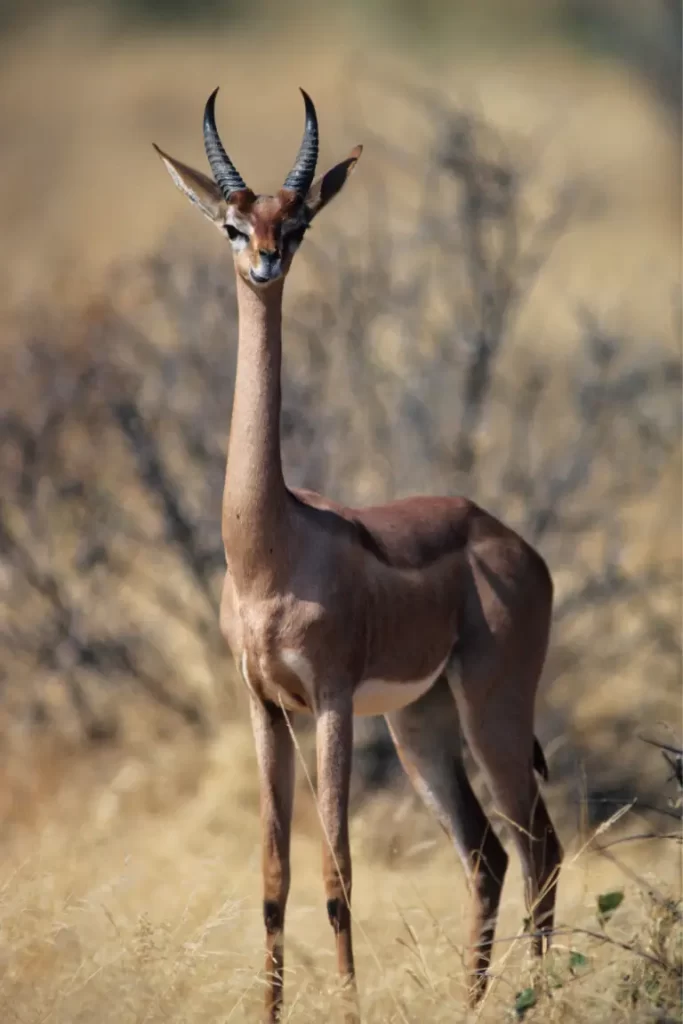
The Gerenuk, or Litocranius walleri, is a relatively small-sized antelope compared to other members of its family. Here are some details about the average size of a Gerenuk:
Height at Shoulder
On average, adult Gerenuks stand at a shoulder height of around 80 to 105 centimeters (31 to 41 inches). This measurement provides an indication of their overall stature and how they compare to other animals of similar body shape and size.
Body Length
The body length of a Gerenuk, from the tip of the nose to the base of the tail, typically ranges from 110 to 150 centimeters (43 to 59 inches). This measurement includes the head, neck, torso, and hindquarters, providing an overall estimate of the animal’s length.
Weight
Adult Gerenuks generally weigh between 28 and 52 kilograms (62 to 115 pounds), with males being slightly heavier than females. Their weight can vary based on factors such as age, sex, overall health, and the availability of food resources in their habitat.
Physical Dimorphism
It is worth noting that male and female Gerenuks display sexual dimorphism, with males being larger and heavier than females. Male Gerenuks also possess impressive, lyre-shaped horns, which can reach lengths of around 25 to 44 centimeters (10 to 17 inches). Females, on the other hand, lack horns and have a more slender appearance overall.
It’s important to remember that these measurements represent average sizes, and individual Gerenuks may vary slightly in their dimensions. Additionally, factors such as geographical location and environmental conditions can influence the size and growth patterns of Gerenuks in different regions.
How long is the neck of a Gerenuk?
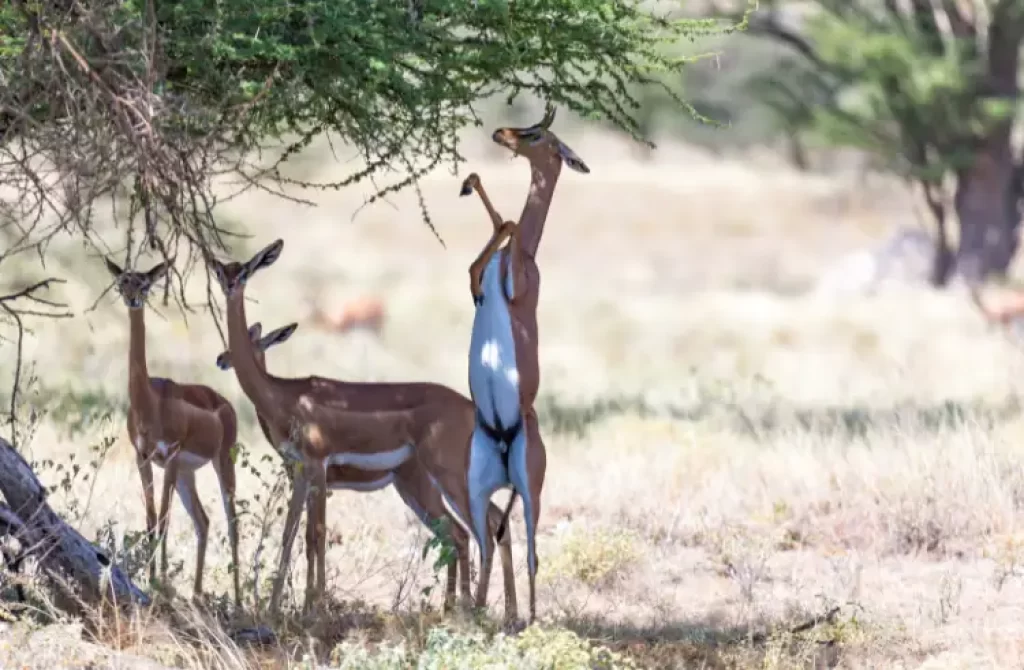
The Gerenuk, or Litocranius walleri, is known for its exceptionally long neck, which is one of its distinguishing features. The length of a Gerenuk’s neck can vary slightly between individuals, but on average, it measures around 50 to 60 centimeters (20 to 24 inches). This elongated neck allows the Gerenuk to reach high branches and foliage, which other grazing animals may find difficult to access.
The specialized neck structure of the Gerenuk is an adaptation that enables it to feed on leaves, buds, and tender shoots found on trees and shrubs.
By stretching its neck upwards and using its elongated tongue, the Gerenuk can browse on vegetation that grows higher off the ground, giving it a distinct advantage in arid and semi-arid habitats where resources may be limited.
The length of the Gerenuk’s neck, combined with its slender body and long, nimble legs, allows it to adopt an upright posture while feeding, standing on its hind legs and extending its neck to reach food sources. This unique feeding behavior gives the Gerenuk its characteristic appearance and sets it apart from other antelope species.
Feeding Behavior of Gerenuks
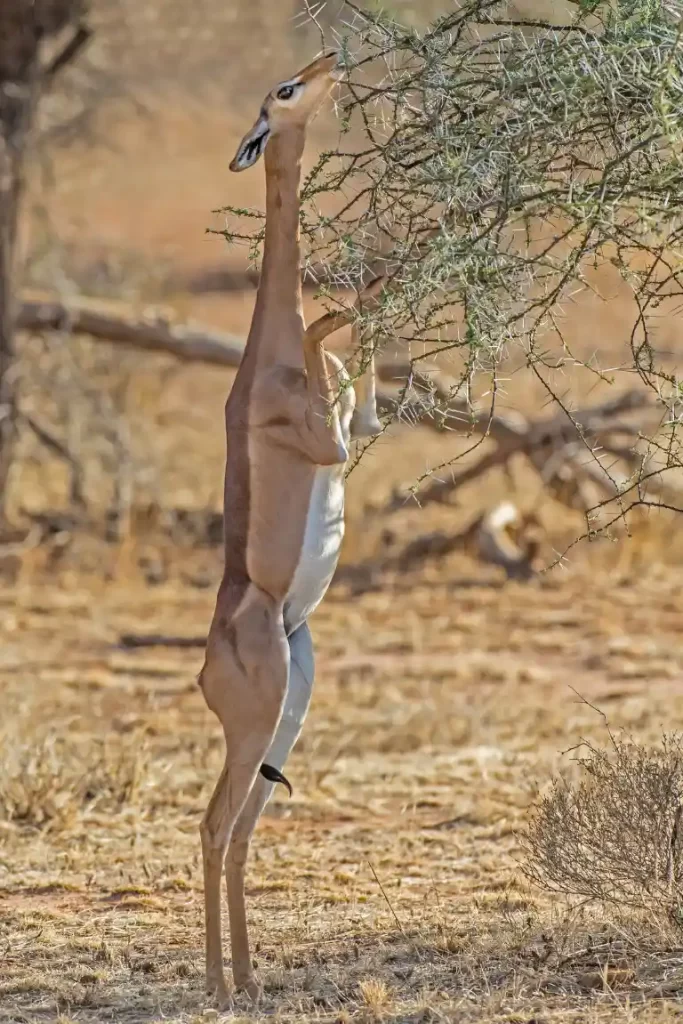
The Gerenuk, also known as Litocranius walleri, is a fascinating mammal with distinct adaptations that allow it to thrive in its environment. One of its most remarkable features is its specialized feeding behavior, specifically tailored to its browsing diet. Let’s delve into the intriguing world of the Gerenuk’s diet and explore how its unique feeding habits contribute to its survival in challenging habitats.
Browsing Specialists: An Unconventional Herbivore
The Gerenuk’s browsing diet sets it apart from other herbivorous mammals. While many herbivores focus on grazing grasses, the Gerenuk has evolved to excel in browsing on leaves, buds, and shoots of various plants. This specialization has shaped its physical characteristics and feeding strategies.
Selective Dining
The Gerenuk is highly selective in its food choices. Its long, slender neck and nimble tongue enable it to reach high branches and selectively browse on the most nutritious parts of plants. By carefully selecting its food, the Gerenuk maximizes its nutrient intake while minimizing the intake of less valuable plant materials.
Reaching New Heights: The Advantages of an Elongated Neck
The Gerenuk’s elongated neck is a key adaptation that allows it to access foliage that other herbivores cannot reach. By standing on its hind legs and extending its neck, the Gerenuk can reach leaves and twigs high in the canopy. This browsing strategy enables it to exploit food resources that would otherwise be out of reach, giving it a competitive edge in its habitat.
Adapting to Arid Environments: Browsing in the Face of Scarcity
In arid and semi-arid habitats, where grasses may be sparse, the Gerenuk’s browsing habits prove advantageous.
It can thrive on woody vegetation, such as acacia trees, which are abundant in these regions. By specializing in browsing, the Gerenuk minimizes competition with other herbivores that primarily rely on grazing, making efficient use of available resources.
Beyond Leaves: Supplementing the Diet
While leaves form the core of the Gerenuk’s diet, it also supplements its nutritional needs with other plant parts. It has been observed feeding on fallen fruits, plucking flowers, and sipping nectar.
This flexibility in its diet allows the Gerenuk to adapt to seasonal variations and exploit additional food sources when available.
Behavior of Gerenuks in the Wild
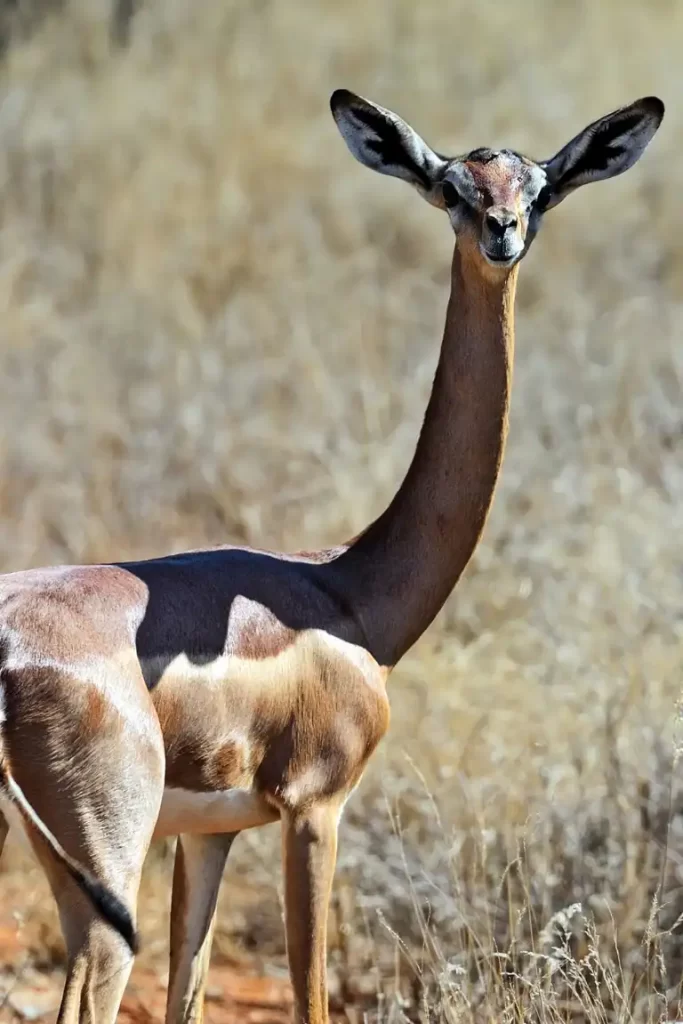
Gerenuks, also known as Waller’s gazelles or giraffe gazelles, are captivating antelopes found in the dry woodlands and savannas of East Africa.
With their unique physical adaptations and distinctive behaviors, they stand out among their fellow antelopes. Let’s delve into the intriguing world of Gerenuks and explore their typical behaviors in the wild.
Browsing Marvels: Expert Tree-Top Foragers
Gerenuks are masterful browsers, setting them apart from the grass-grazing antelopes. Their elongated muzzles and long necks allow them to effortlessly reach for leaves, shoots, and twigs on higher branches, which would be inaccessible to other antelope species.
In a remarkable display, Gerenuks can often be seen standing on their hind legs, stretching their bodies to browse from the uppermost parts of acacia trees. This extraordinary behavior, known as “stotting” or “giraffe browsing,” showcases their adaptability and resourcefulness.
Solitude or Small Family Groups: An Independent Lifestyle
Gerenuks typically exhibit a solitary lifestyle, only occasionally forming small groups consisting of a female and her offspring.
Unlike more gregarious antelopes, Gerenuks prefer maintaining their own company, venturing through their arid habitats independently. This behavior is a testament to their self-reliance and ability to thrive in solitude.
Nocturnal Wanderers: The Cover of Darkness
Gerenuks are primarily active during the early morning and late afternoon, strategically avoiding the sweltering heat of the day in their arid environments. Additionally, they may display nocturnal behavior in areas where human disturbances are common.
This adaptation allows them to find sustenance and roam their territories under the cover of darkness when potential threats are reduced.
Thriving in Arid Environments: Remarkable Adaptations
Gerenuks have evolved impressive physiological adaptations to cope with their arid habitats. Their kidneys efficiently conserve water, enabling them to derive most of their hydration from the moisture in the vegetation they consume.
Furthermore, Gerenuks possess a remarkable tolerance for high temperatures. They have large, thin ears that aid in dissipating heat, preventing overheating and maintaining their comfort in scorching climates.
Ever-Vigilant Guardians: Sharp Senses for Survival
Gerenuks are alert and cautious animals, always on the lookout for potential danger. With exceptional eyesight and keen hearing, they possess an innate ability to detect the presence of predators such as lions, leopards, and hyenas.
When sensing danger, Gerenuks can swiftly evade their pursuers by employing a zigzag running pattern, bewildering their would-be attackers and increasing their chances of survival.
Some unique physical adaptations of Gerenuks
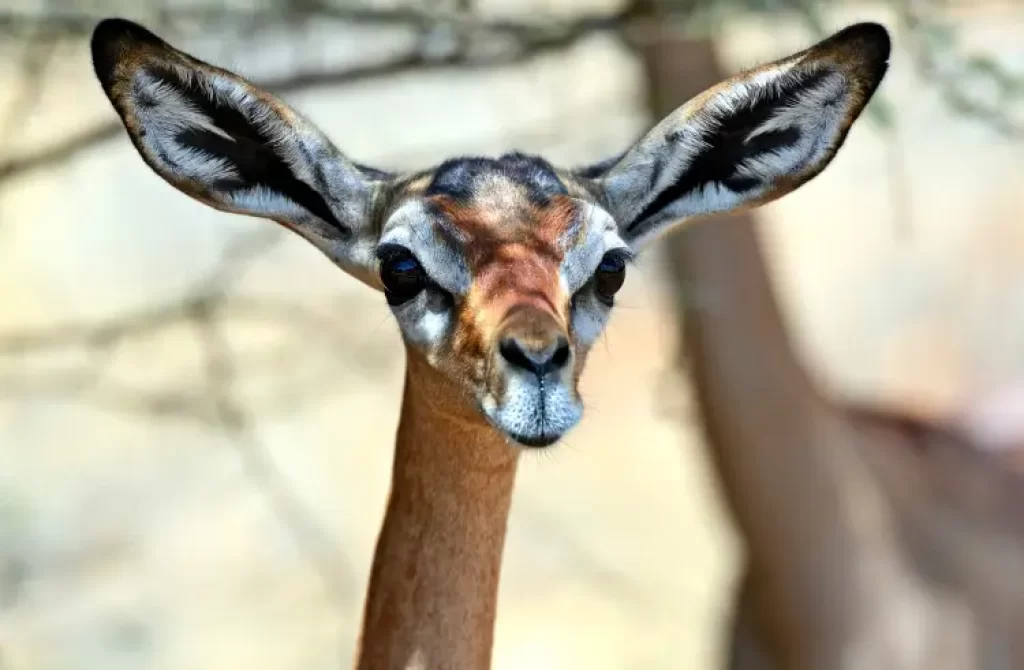
Gerenuks possess several unique physical adaptations that enable them to thrive in their arid environments.
Here are some notable adaptations of Gerenuks:
Long Neck and Elongated Muzzle
Gerenuks have remarkably long necks and elongated muzzles, which allow them to reach vegetation at greater heights. This adaptation enables them to browse on leaves, shoots, and twigs of bushes and trees that other antelopes cannot access.
Standing on Hind Legs
One of the most distinctive physical adaptations of Gerenuks is their ability to stand fully upright on their hind legs. This behavior, known as “stotting” or “giraffe browsing,” allows them to stretch their bodies and reach even higher branches.
By utilizing their hind legs and elongated necks simultaneously, Gerenuks can access an abundant food source that is beyond the reach of many other herbivores.
Efficient Kidneys
Gerenuks possess highly efficient kidneys that enable them to conserve water effectively. In their arid habitats, water is a scarce resource, and these antelopes have evolved to minimize water loss through urine production.
This adaptation allows them to derive most of their hydration from the moisture contained within the vegetation they consume, reducing their dependence on external water sources.
Large, Thin Ears
Gerenuks have large, thin ears that aid in thermoregulation. In hot environments, these ears serve as effective radiators, facilitating the dissipation of excess heat from the body.
The large surface area of their ears helps in cooling down, allowing Gerenuks to tolerate higher temperatures and adapt to the challenging climate of their habitats.
Modified Teeth and Jaw Structure
Gerenuks possess specialized dental adaptations suited for browsing. Their incisors are elongated and sharp, allowing them to grasp and tear foliage with precision. Additionally, their jaw structure enables efficient chewing and processing of tough vegetation, facilitating nutrient extraction from their browse-dominated diet.
These physical adaptations of Gerenuks have evolved over time, equipping them with the tools necessary to navigate their unique ecological niche and thrive in arid environments where resources are scarce.
Special Mating rituals of Gerenuks
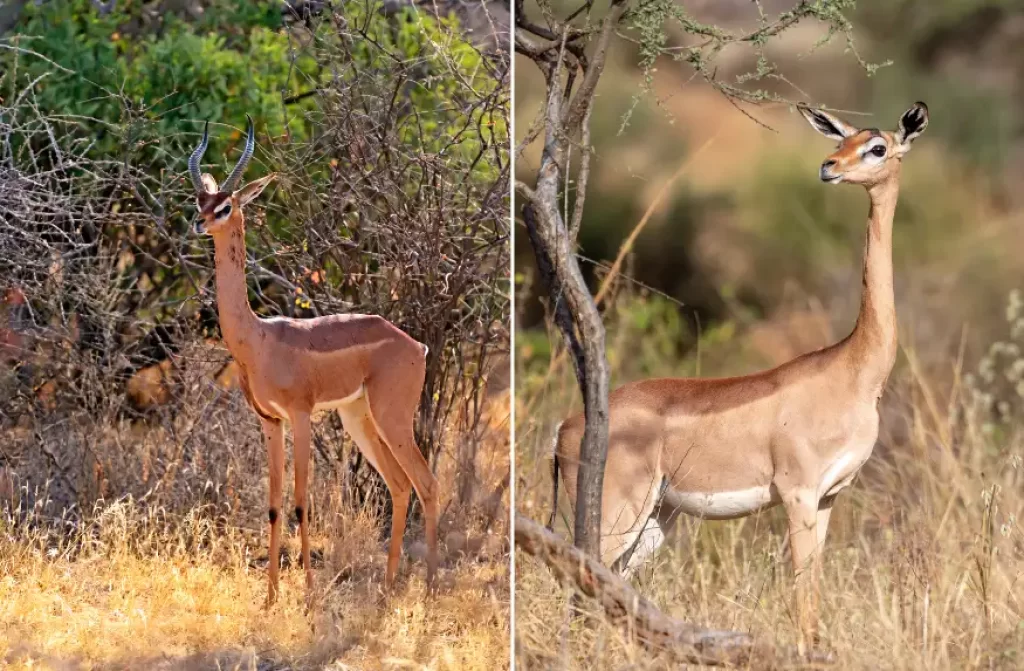
Gerenuks do not have elaborate or distinct mating rituals compared to some other species. However, they do exhibit certain behaviors related to courtship and mating. Here are some observations regarding Gerenuk mating:
Scent Marking and Display
During the mating season, male Gerenuks may engage in scent marking to establish their presence and attract females. They may rub their preorbital glands against trees or vegetation, leaving behind scent marks as a means of communication.
Chasing and Courtship Displays
Male Gerenuks may engage in chasing behaviors, pursuing females as a display of their strength and fitness. This chasing behavior can be observed during courtship, where the male showcases his abilities to the female.
Head Tossing and Neck Maneuvers
To attract females and display their physical prowess, male Gerenuks may perform head tossing and neck maneuvers. This can involve raising their heads high and tossing them side to side, showcasing their strength and agility.
Sniffing and Flehmen Response
When a male encounters a receptive female, he may engage in sniffing behavior to assess her reproductive status. This behavior involves the male sniffing the female’s genital area to detect pheromones and gather information.
Additionally, the male may exhibit the Flehmen response, which involves curling back his upper lip and inhaling the scent for further assessment.
Reproductive Hierarchies
In areas where Gerenuk populations are denser, there may be a hierarchy among males based on dominance and access to mating opportunities. Dominant males are more likely to secure mating privileges with receptive females, while subordinate males may have limited or no reproductive success.
Gerenuks Defensive Mechanisms
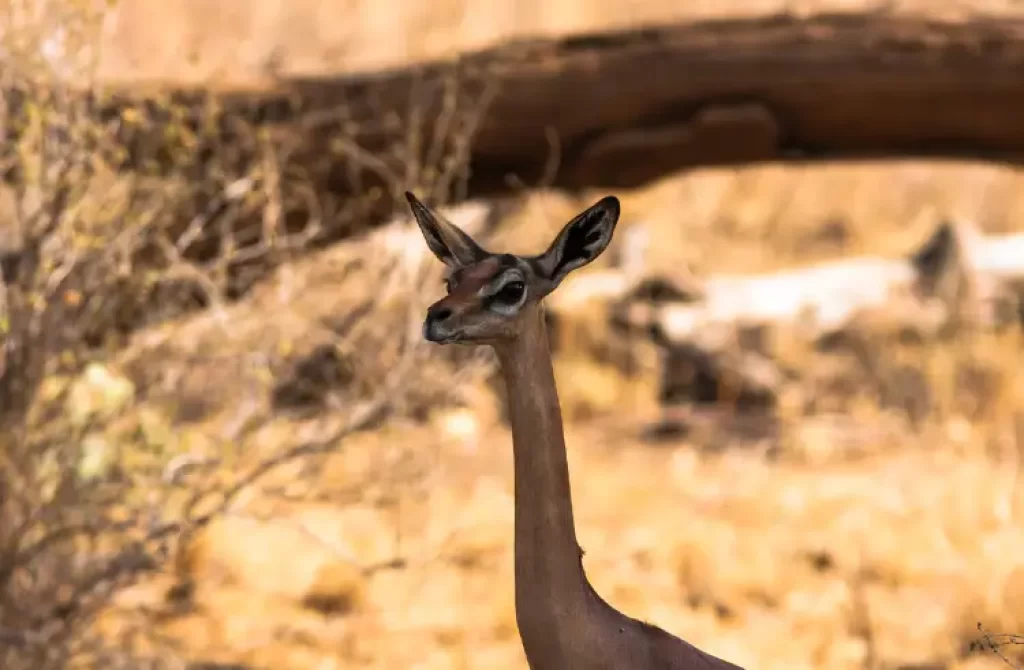
Gerenuks have evolved various defensive mechanisms and behaviors to protect themselves from predators in their natural habitat. Here are some ways Gerenuks defend themselves:
Vigilance and Alertness
Gerenuks are extremely vigilant and possess keen senses. They have excellent eyesight, allowing them to spot potential threats from a distance. They also have acute hearing, which helps them detect the presence of predators even when they are not in direct line of sight.
Their ability to remain alert and aware of their surroundings enhances their chances of detecting predators early.
Agile Escape
When faced with a potential threat, Gerenuks rely on their speed and agility to escape. They are swift runners and can reach speeds of up to 56 km/h (35 mph). Gerenuks often employ a zigzag running pattern to evade predators, making it challenging for them to lock onto a moving target.
Leaping and Dodging
Gerenuks are adept at maneuvering through their environment. When pursued by predators, they utilize their nimble bodies to leap and dodge obstacles such as bushes, trees, and uneven terrain. This evasive action helps them to create distance and confuse their attackers.
Group Alertness
While Gerenuks are generally solitary or found in small family groups, they can benefit from group vigilance. Individuals within a community can alert each other to the presence of predators through vocalizations or body language, providing a collective defense mechanism against potential threats.
Camouflage and Concealment
Gerenuks have a unique reddish-brown coat that blends well with the dry, arid habitats they inhabit. This coloration helps them camouflage among the shrubs and vegetation, making it harder for predators to spot them.
Additionally, Gerenuks may seek shelter in dense vegetation or behind obstacles, utilizing natural cover to remain concealed from predators.
Defensive Kicking
If cornered or unable to escape, Gerenuks can resort to defensive kicking as a last line of defense. Their strong legs and sharp hooves allow them to deliver powerful kicks, potentially inflicting injury on a predator. This behavior serves as a deterrent and may provide an opportunity for escape.
Frequently asked questions (FAQ)
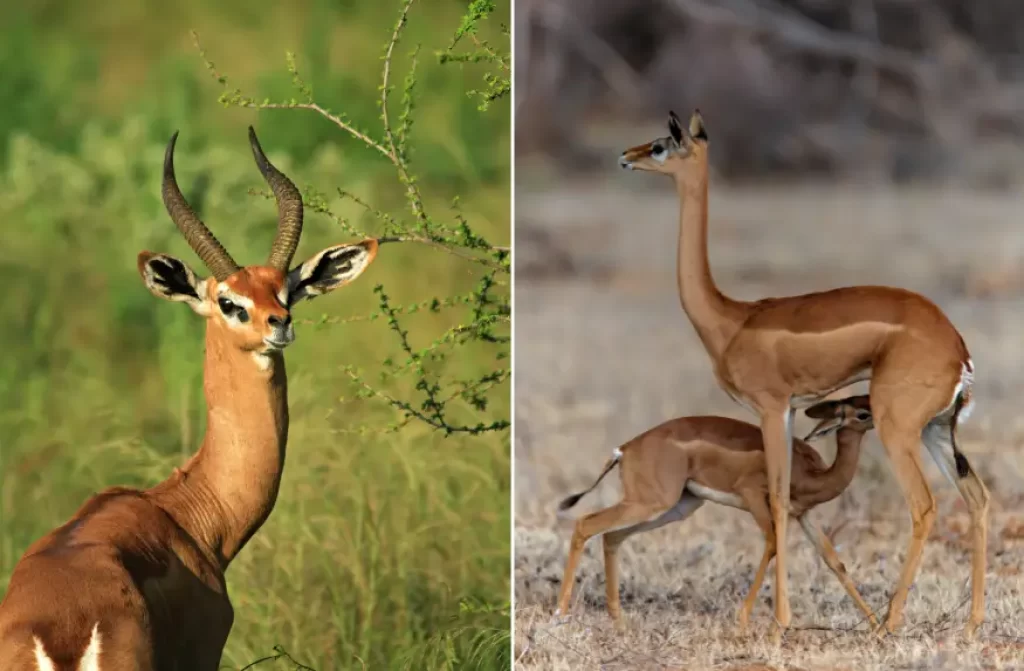
Are Gerenuks capable of jumping?
Gerenuks are capable of leaping and making agile movements when necessary. While they are not known for long-distance jumping, their elongated necks and powerful hind legs allow them to perform impressive vertical leaps. They use this ability to reach higher branches while browsing and to navigate their environment, evading threats by leaping over obstacles and changing direction rapidly.
Can gerenuks swim?
No, Gerenuks are not known for their swimming abilities. They are adapted for life in dry and arid habitats, and their physical characteristics are more suited for browsing on vegetation and navigating terrestrial environments. Gerenuks have long, slender legs and are well adapted for running and leaping rather than swimming. They primarily inhabit areas where water sources are limited, and their survival strategies revolve around conserving water rather than swimming across bodies of water.
What country do gerenuks live in?
Gerenuks primarily inhabit the eastern African countries of Kenya, Somalia, and Ethiopia. These countries, particularly the arid and semi-arid regions within them, provide suitable habitats for Gerenuks to thrive. They are adapted to the challenging conditions found in these areas, including the dry savannahs, bushlands, and other arid landscapes. While their range is primarily focused in eastern Africa, Gerenuks may also be found in neighboring regions within those countries.
Can Gerenuks survive in arid environments?
Yes, Gerenuks can survive in arid environments. They have adapted to these harsh conditions by conserving water, being expert browsers, having effective thermoregulation with large ears, and possessing camouflage. Their ability to thrive in arid habitats is due to these adaptations that help them find food and water while coping with the challenges of the environment.
Do Gerenuks migrate or have a sedentary lifestyle?
Gerenuks have a sedentary lifestyle and do not migrate long distances. They establish home ranges and remain within them throughout the year, with only occasional short-distance movements within their territories.
What type of climate do gerenuks live in?
Gerenuks inhabit arid and semi-arid regions, typically characterized by dry climates. They are adapted to live in areas with limited rainfall and sparse vegetation. The climate in their habitats can be described as hot and dry, with fluctuating temperatures throughout the year.
Gerenuks are well-suited to thrive in such environments where water availability is low. They have evolved physiological and behavioral adaptations to cope with the challenges of arid climates, including their ability to conserve water and their browsing behavior to access higher foliage where moisture content is relatively higher.
These antelopes are commonly found in the dry savannahs, bushlands, and scrublands of eastern Africa, where they can effectively navigate and utilize the available resources in their arid habitat.
Final thoughts
The Gerenuk is a fascinating antelope species that thrives in the arid landscapes of East Africa. With its unique physical adaptations, such as elongated necks and powerful hind legs, the Gerenuk has evolved to browse on vegetation at greater heights, allowing it to survive in environments where food resources are scarce. Its ability to conserve water and withstand the challenges of arid climates is truly remarkable.
If you found the Gerenuk intriguing, we invite you to explore other articles on our website. Discover more about the diverse wildlife of East Africa, their remarkable adaptations, and the captivating ecosystems they inhabit. From towering giraffes to majestic lions, there is a wealth of information waiting to be uncovered.
References:
- Gerenuk Wikipedia article. Available at: link to the Wikipedia article on Gerenuk
- Gerenuk on The IUCN Red List site. Available at: link to the IUCN Red List page on Gerenuk







